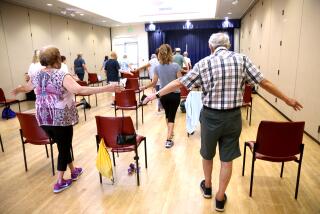Careful Planning and Little Comforts Can Help Smooth the Way for Seniors
- Share via
It’s said that you don’t know a man until you walk a mile in his shoes. And you also don’t know what it’s like for older people to travel until you accompany one on a trip.
After flying with my elderly father from Washington, D.C., to L.A. in July, I began to realize that a companion has important tasks that can make a journey easier on older people. Most of the tips have to do with flying, such as packing snacks, putting prescriptions in carry-ons and taking a light blanket, which was invaluable to my father because he tended to get cold.
I booked nonstop tickets on JetBlue to avoid tiring, discombobulating connections, and we flew into small, manageable Long Beach Airport, which kept my dad from feeling overwhelmed. Even though my father could walk, I arranged with the airline for wheelchair assistance, which meant we got to board first and were given easily accessible bulkhead seats.
When I took him back to the airport for his return flight to Washington, I got permission from JetBlue to wait with him at the gate instead of saying goodbye at the security checkpoint. I wished he’d had a first-class seat and access to a comfortable airline club. Better yet, I wish I had flown with him both ways. As I watched the attendant wheel him to the lift that took him from the tarmac to the plane, I felt like an anxious mom sending her child to school for the first time.
Things can go awry on a plane trip. Dr. Alan Spira, a Beverly Hills travel medicine specialist, says that seniors may be especially prone to blood clots from long stints in economy-class seating. Swelling of lower legs and feet is common too, for which Spira recommends compression stockings.
And then there is the horrifying story about Joe and Margie Dabney, who flew from Indianapolis to LAX in December. When they landed at Dallas/Fort Worth International Airport, a wheelchair attendant met them to help with a connection. But somehow Margie, who had Alzheimer’s disease, disappeared, and she remained missing as of the Travel section’s deadline Tuesday. (The national Alzheimer’s Assn. says that half the 4 million people who suffer the disease wander away at times.)
I didn’t need to worry about my father wandering away; at 82, his mind was sharper than mine. But his hearing was poor, so I worried about what would happen if he missed an important announcement. Fortunately, everything went just fine. Careful planning made the trip successful. This involves finding out about available services for seniors, beginning when you book a flight. It’s important to tell the agent the senior’s age and degree of mobility so requests, such as a wheelchair or a special meal, can be noted. Talula Guntner, a professor of travel and tourism at Northern Virginia Community College in Annandale and a specialist in mature travel, says the efficiency of wheelchair service for seniors varies, not so much from airline to airline but based on the sensitivity of the personnel. On a plane or cruise ship, she says, you have to “keep after it” by booking the wheelchair and calling back later to reconfirm.
Some seniors with reasonable mobility bristle at the idea of using a wheelchair, even though it makes passage through crowded terminals easier and faster. Guntner advises their travel companions to say, “Please, do it for me. Wheelchair attendants take shortcuts, and we’ll get priority seating.” Information about airport facilities for seniors (and disabled travelers), such as pay telephones for hearing-impaired travelers or elevators and bathrooms with handicap facilities, is available on most airline Web sites. The Travelers Aid Society at LAX (www.tasla.org) and other hubs provides attendants to help older people make flight connections (though its personnel aren’t allowed to push wheelchairs).
American Airlines’ SkyCAAre program allows passengers to arrange, at the time of flight booking, for emergency room-trained nurses to accompany them every step of the way. SkyCAAre nurses help with meals and getting around and, in an emergency, can administer medical aid.
The service costs $90 an hour (charged during flight time only) and requires the passenger to purchase a seat for the nurse (at a 30% discount). Dr. David McKenas, American Airlines’ medical director, says the service often is used for seniors transferring to or from nursing homes, though elderly vacationers traveling with relatives use it because it relieves their companions.
Before flying with my father, I had hoped to take him with me on a trip to Switzerland, which involved an overnight flight to Zurich, immediately followed by a five-hour train ride to Zermatt. He couldn’t make it, which turned out to be a good thing. I hadn’t planned the trip with an 82-year-old in mind, and it taxed even me.
Next time I travel with a senior, I’ll know better. And because they make such excellent companions, I hope there will be a next time.
More to Read
Sign up for The Wild
We’ll help you find the best places to hike, bike and run, as well as the perfect silent spots for meditation and yoga.
You may occasionally receive promotional content from the Los Angeles Times.






